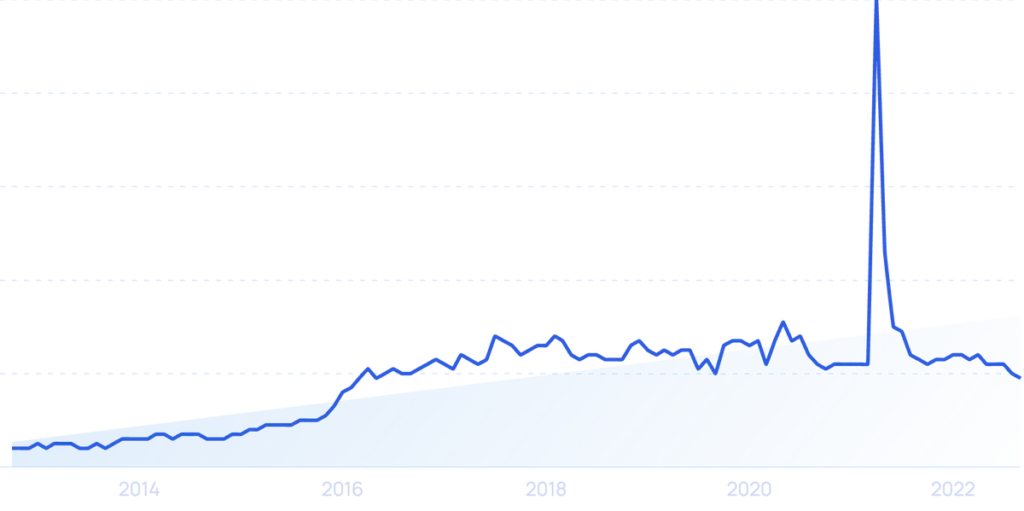At what point does consumer behavior justify investing in a permanent listing, technology, or a seasonal experience?
When planning your marketing strategy or product innovation, you need to weigh the influence trends will have on your consumers and what investments will drive sales.
Let's start by looking at a new way of categorizing these insights by breaking them down by fads, trends, and breakthroughs. Many can benefit your business, but the key is knowing when to make the right moves.
So, what’s the difference?
Defining a Marketing Fad
A fad is essentially a short-term surge in demand and a spike of shared interest.
Consumers hear about a new flavor profile or superfood ingredient and are motivated to try it. We see fads grow through word of mouth, social experiments going viral, celebrity endorsements, and POS in stores, etc. Some examples of this are mushroom products, nostalgia snacks, sweet & spicy ("swicy") flavors - even butter boards. Watching people in your neighborhood play Pokémon Go was a great example of a fad. Most fads are short-term, so take advantage of them in communication or campaigns, through a line extension of a flavor, or seasonal programs / sponsorship.
Innovation catalyzed by fads can lead consumers to trial your product, add to their basket size, and/or bring awareness to your brand of a new audience. Use a minimum investment through your marketing budget and not a major capital expense.
Defining a Marketing Trend
A trend is indicated by longer-term behavioral and demand changes in the market.
Trends typically arise from new research, studies, or revelations that begin to permeate society and shift eating patterns or perceptions. The new attack on refined sugar has come through new studies on fat, obesity and diabetes, and the effects of a high sugar diet. There was a time when smoking was considered "healthy" until research and studies proved otherwise, and the tobacco industry started to fall fast in countries that educated consumers to the fact.
The understanding of and new insights on the importance of gut-health has led to the rise of fermented products like kombucha, sourdough, and fermented ingredients. Climate change, environmental sensitivities, and research on the negative effects of heavy animal-based diets has led to the explosion of plant-based foods, vegan, vegetarian diets and "cruelty free" options.

[Data via Exploding Topics]
Research on the effects of alcohol (physical, emotional, societal) is leading to the rise of zero-proof drinks and the growth of the non-alcoholic category. Trends have the power to create new segments, support new SKUs, flavors and formats, or even create a need to overhaul the core portfolio.
Trends can provide an effective opportunity for expansion or a risk to be left behind. Often these decisions will require capital expenses in new equipment or manufacturing capabilities, or a perception shift on what your current brand stands for. Leverage your core brand and consider the use of sub-brands to focus on the benefit consumers are seeking and ensure the innovation or trend fits.
Defining Breakthroughs
A breakthrough is a longer-term consumer shift or change that is created from the discovery or launch of new technology. Breakthroughs can change how consumers shop, consume your product, or how you manufacture it. They require a significant capital investment and organizations with the most vision, foresight and appetite for risk will be the ones to go for it. For example, when Coke moved from glass to plastic bottles - it was a huge investment, but it changed how people transported and consumed soda. Another example is the rise of eCommerce and smart phones. They changed the way consumers shop, are educated about products, and how they communicate with each other and with brands.
Smaller breakthroughs we see on the horizon include consumable/dissolvable packaging, ghost kitchens for the QSR industry to serve the rise of food delivery apps, and upcycled ingredients (ex., non-dairy milk pulp). Carbon neutrality or net zero (offsetting carbon emissions through the production process) is one trend that will become a breakthrough now that it's being legislated in some regions and more widely understood by consumers.
Larger breakthroughs in how food is made are taking big strides through vertical farms and cellular agriculture. Imagine when your steak is made in a lab, and it will still be delicious and less expensive. Once a breakthrough occurs, very rarely, does behavior or change ever go back.
Fads, Trends & Breakthroughs in 2024
Our predictions for 24' included:
- Smaller product sizes & samplers
- A US Presidential campaign causing increased media noise, costs & polarization
- More AI in your organization (In a good way)
- CPG Brands increasingly looking at collabs & Partnerships
- YouTube Shorts making more noise
- More multipacks
- First party data importance talk gets louder
- PR being used more for product launches & awareness building
Fads, Trends & Breakthroughs in 2023
Our 23' fads and trends predicted:
- Innovative Ingredients
- Global Flavours
- Zero-proof alcohol
- No sugar products
- Continued plant-based performance
- Functional foods rise
- Convenience is king
- Smart packaging
- Vertical farming
- Celluar agriculture
Fads, Trends & Breakthroughs in 2022
Our 22' trends predicted:
- Ultra-urban farming
- “Reducetarianism”
- Bottled cocktails
- Non-alcoholic spirits
- Bubbles with a benefit
- CBD
- Environmentally friendly food
- Turmeric
- Yuzu
- Spicy foods
Food Trends in 2021
In 21' our predictions included:
- Going Greener
- More Authenticity
- Resurgence of Single Serve
- Plant-based Nutrition
- Making an impact
- Functional foods
- Breakfast Reimagined
- Comfort Food
- Mighty-Micro Influencers
- Feeding the Digital World
Every organization should take advantage of fads, trends, and breakthroughs within their strategy. Conducting regular consumer research to stay up to date and to evaluate these decisions is critical. There will be both short-term and long-term investments, but the key here is to act and not be left behind.
If you need help in seeing what's next and evaluating courses of action, come talk to us. We'd love to help.

